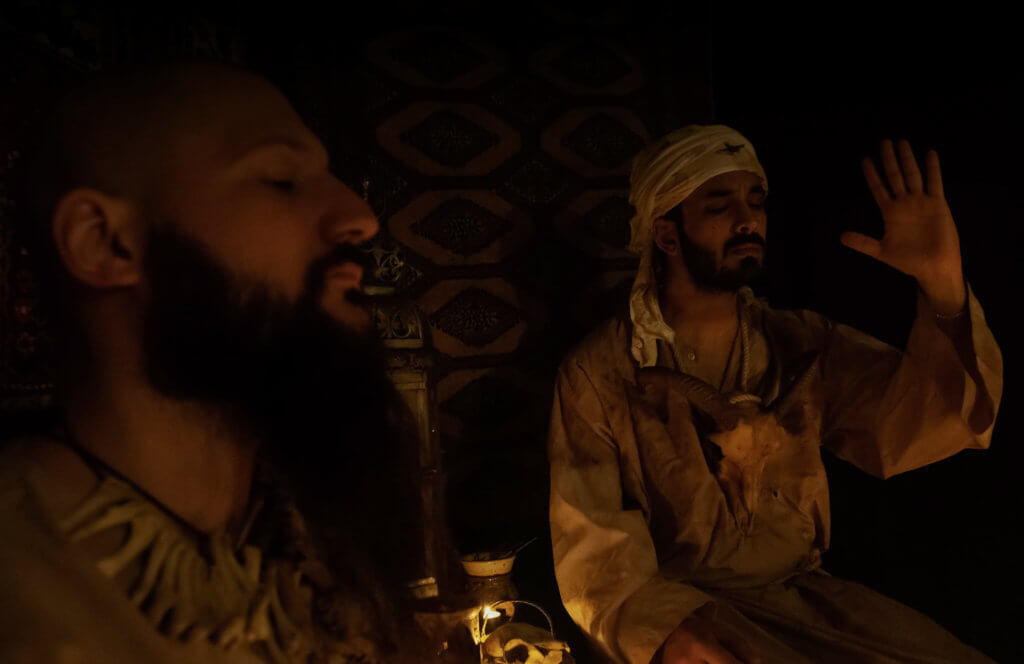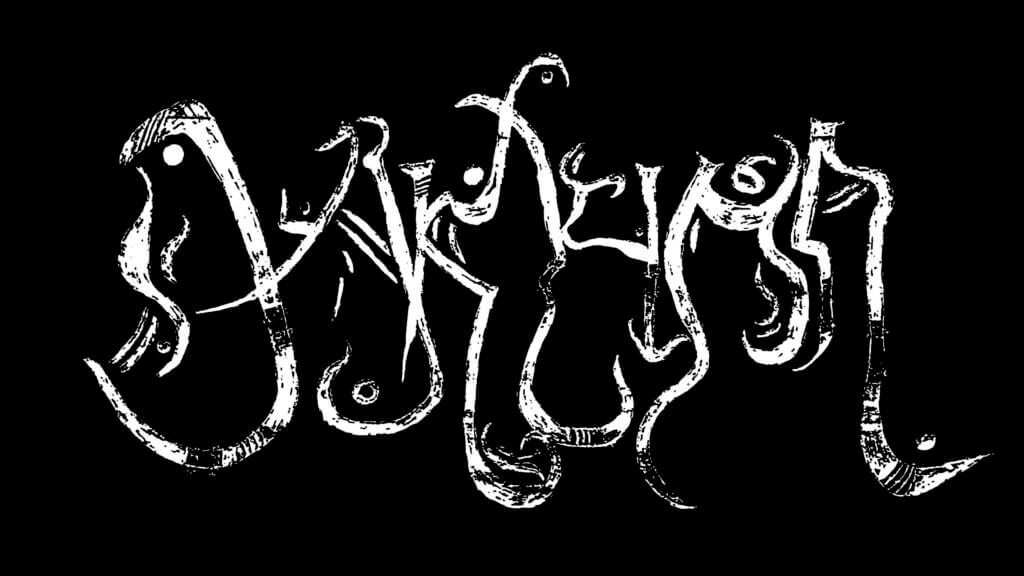“THE FACT THAT SOMETHING LIVES ONLY FOR A LIMITED TIME VASTLY INCREASES THE VALUE OF THAT TIME” – KARAPAN DARVISH (DAKHMA)
Shrouded in ancient Persian mysticism, the singular Death Metal of Dakhma soared to new heights of celestial obscurity on second full-length, ‘Blessings of Amurdad’. Traversing the centuries in search of truth, chief composer and celebrant Karapan Darvish contemplates the divine gift paradoxically bestowed upon mortals by the promise of death; the influence of Zoroastrianism on contemporary culture; man’s futile quest for demystification; the oftentimes opposing teachings of science and religion; and the inevitable demise of traditional death rituals deemed too grotesque and macabre for the modern world.
 Dakhma conjures and channels an exclusive form of Zoroastrian Death Music. Why have you chosen to adopt this distinctive ideological approach to your art? Which came first with Dakhma – the music or the thematic concept that weaves everything together? Or did everything take form simultaneously, organically?
Dakhma conjures and channels an exclusive form of Zoroastrian Death Music. Why have you chosen to adopt this distinctive ideological approach to your art? Which came first with Dakhma – the music or the thematic concept that weaves everything together? Or did everything take form simultaneously, organically?
“The main reason why Dakhma explores Zoroastrianism is my personal interest in the topic. As such, I would say that the music followed on from my fascination with the themes of the religion and culture. All projects I’m involved with creatively have a strong thematic and conceptual underpinning, which I feel serves as valuable context for the music. Specifically for Dakhma, I suppose I was abstractly aware of the existence of Zoroastrianism at a young age due to my Persian heritage. Upon travelling in Iran several years ago, I was exposed to the religion (or rather, the remnants of it and its modern exercise) and was eager to delve into its concepts of theology and cosmogony more fervently.
“The music we create primarily derives from the more mystical and sinister ideas present in the religion, but I suppose several kinds of music could be inspired by Zoroastrianism. The fact that our music is more rooted in sounds of extreme metal stems from our affinity to and passion for these sounds, yet I believe the concepts of Zoroastrianism and ancient Persian mysticism allow us to explore sounds largely foreign to extreme metal, which is in and of itself primarily a modern European form of musical expression. To answer your question more directly, while for Dakhma the concept and theme were (at least loosely) defined prior to music having been recorded, the ideas of how Dakhma should sound were certainly formed organically, as I consider them to derive from the themes we explore.”
Furthermore, as Satan and Satanism derive directly from the Zoroastrian adversarial entity Angra Mainyu – and serve as an important source of inspiration for much Death Metal and Black Metal – can we legitimately argue that this ancient belief system influences most if not all extreme music and culture?
“I would say that is a valid argument. As far as I’m aware, few religions exist in isolation, but are rather inspired from ideas that came before them. Zoroastrianism is widely recognised as the first monotheistic religion and one of the first religions to define the desirable versus the undesirable in terms of ‘good’ and ‘evil’, going so far as to personify these – albeit vague – concepts in divine entities (i.e. Ahura Mazda and the adversarial Angra Mainyu).
“Thus, it naturally follows that contemporary dominant monotheistic religions were at least inspired by Zoroastrianism as pertains to how they (at least in the most simplistic terms) view the nature of the divine in an adversarial struggle between God and ‘the’ Devil. On the other hand, I would argue that few extreme metal projects are aware of Zoroastrianism and its influence on modern monotheistic religion. Lacking any such awareness, it is difficult to determine any significance the influence of Zoroastrianism may have on an extreme metal band not aware of (and likely not interested in) it.
“As for the influence of Zoroastrianism on contemporary culture, I should note that I am not a scholar on these subjects but merely an interested and passionate layman. Regarding your question, I’m sure there is an argument to be made here. However, considering that some of the most important concepts of Zoroastrianism pertain to ritual practice and contain a plethora of contentious, differing theological thought, any influence at this point is certainly watered down to being of an indirect nature, largely delegated to very general conceptual terms as loosely outlined above.”
 As the oldest dualistic and monotheistic faith, Zoroastrianism – like paganism – has been plagiarised and cannibalised by the obscenely popular and powerful Abrahamic religions. Is this a compliment or an insult to Zoroaster? Does the fact that they have borrowed or stolen so many of their main tenets from pre-existing belief systems render Christianity and Judaism at best dishonest and at worst complete fabrications?
As the oldest dualistic and monotheistic faith, Zoroastrianism – like paganism – has been plagiarised and cannibalised by the obscenely popular and powerful Abrahamic religions. Is this a compliment or an insult to Zoroaster? Does the fact that they have borrowed or stolen so many of their main tenets from pre-existing belief systems render Christianity and Judaism at best dishonest and at worst complete fabrications?
“I would not necessarily view the development you suggest in such confrontative terms. As far as I can tell, it is only natural for humans to base their belief systems on what came before them; borrowing concepts of the past and adapting them to new situations or implementing them in newer belief systems is something that can be observed throughout the history of religion. As a religion spreads (often through violent conquest), it will have difficulty surviving in the minds of the conquered if it is viewed as something completely foreign to what the conquered know. Thus, many religions adapt the ‘old’ local rituals and symbolism and contextualise or integrate them into their ‘catalogue’ of rituals and practices. A popular example of this is certainly the symbol of the Christian Devil’s trident, borrowed from Poseidon and recontextualised to emphasise the diabolical / heretical nature of the pagan ancient Greek polytheistic religion. Another such example is the idea of Christmas as a celebration of the birth of Christ being in December (to coincide with pagan yule celebrations), while it is widely believed that the historical Christ was born in the summer time.
“Whereas these examples show how religions integrate (or, as you state, plagiarise) local ritual and practice in order to secure popularity and increase familiarity with those being exposed to them, I would argue that the adoption of Zoroastrian theological concepts in the Abrahamic religions is of a different nature. Here, the theological concepts of Zoroastrianism, i.e. the dualistic nature of good versus evil, were adopted. I would not necessarily agree that this makes Abrahamic religions a ‘complete fabrication’, as you appear to suggest. Rather, it appears to me this is merely an example of how religious belief systems develop over time. A wholly unique idea or concept is exceedingly rare in most fields.”
In Zoroastrianism, the world is viewed as a battleground between good (represented by Ahura Mazda) and evil (represented by Angra Mainyu), with the former destined to prevail in the end. Does Dakhma take a side in this ongoing struggle between darkness and light, or are you playing the role of an interested, impartial observer?
“I would say we are most interested in how the world and the divine are portrayed in Zoroastrianism, particularly the order of the universe and the concepts of time. As such, at least currently, we are more interested in exploring these concepts from the perspective of a narrator or a character within the ‘story’ of a song, for lack of a better term. We are, however, very interested in this eternal cosmic struggle and I personally find it fascinating to explore the concepts considered to be heretical in Zoroastrianism.” Could you elaborate on what some of these heretical concepts are?
Could you elaborate on what some of these heretical concepts are?
“What I have found particularly fascinating is Zurvanism, which can be loosely described as an extinct sect of Zoroastrianism that differed somewhat radically from central Zoroastrian beliefs. Crucially, Zurvanism – as I understand it – assumed that the supreme being Ahura Mazda was not the Creator, but rather created as an incarnation of all that is good along with a twin brother, Angra Mainyu, an incarnation of all that is evil. The creator of these twin entities was believed to be infinite time, or Zurvan Akarana. I understand that there is some dispute as to translations and interpretations of the texts that present this ‘twin brother’ doctrine, however, I find it a fascinating idea worth exploring.”
Zoroaster is credited as one of the founders of astrology. The study of astral bodies has since led to theories which appear to contradict many religious beliefs, with Galileo for example being branded a heretic in the 1600s for supporting the heliocentric theory – that the sun and not the earth is positioned at the centre of the universe. Are science and religion mutually exclusive? Does science disprove the existence of god? Or is science in fact another form of religion, where unreliable data and theories masquerade as proven facts?
“I’m afraid this question is bursting the realm of what I feel qualified to offer an opinion on, but I’ll do my best to offer some perspective on how I view these things. Whereas religion can provide some people (i.e. those who ‘believe’) with some guiding principles to lead lives in accordance with what the religion they prescribe to views as a desirable path, science – or, more importantly, the scientific method – offers explanations of phenomena by positing a theory based in natural science (physics, chemistry etc.) as we understand these fields at a certain point in time and attempting to prove the theory by repeatable experimentation or observation. I would argue that these approaches differ widely in nature, and it would be misleading to claim that science is merely another form of religion. Whereas religion asks you to believe that which you cannot observe, science attempts to explain what is observed, ideally without regard for belief.
“By means of an example, a religion may tell you that the earth was created a few thousand years ago and require you to believe in this. Science would rather attempt to explore the age of the earth without bias towards an inherent belief for the answer to that question to fit in. It is, in my estimation, a more honest and curious approach to discovering and explaining observable and non-observable phenomena. However, the merits of a scientific explanation are causally linked to the quality of data they rely upon, as you seem to imply in your question. Here, again, I would argue that the difference between science and religion is that science allows for change and improvement based on better data, whereas religion is more rigid in the ideas it asks an observer to believe in.”
 Since time immemorial, man has been engaged in a constant search for meaning and comfort. While the answers to the mysteries of life and death remain largely elusive (or at least unproven), and the craving may appear a futile one at times, does our curious and ambitious nature dictate that this quest for demystification must go on?
Since time immemorial, man has been engaged in a constant search for meaning and comfort. While the answers to the mysteries of life and death remain largely elusive (or at least unproven), and the craving may appear a futile one at times, does our curious and ambitious nature dictate that this quest for demystification must go on?
“In a sense, I suppose modern man is compelled to further explore what is unknown and as such, is somewhat doomed to pursue demystification. However, the unknown is different from the unknowable. Even now, with all of mankind’s technological abilities, the most basic questions of existence remain, to an extent, a mystery. While I find it difficult to argue for or against ‘progress’ in the quest for demystification, I believe it is crucial to study non-current hypotheses for unexplainable phenomena, if only to obtain insight into the culture that proposed the explanation from a historical perspective.”
Thematically, the second Dakhma full-length, ‘Blessings of Amurdad’ (Amerdad being the Zoroastrian divine concept of immortality), explores the complex relationship between the gods and mortals in ancient Persia, specifically looking at perceived jealousies that might have existed between both parties. While the narcissism and arrogance of humanity is such that it is not difficult to surmise why we would aspire towards godliness and immortality, what aspects of the human journey might a god crave? The gifts of free will, self determination, carnal pleasures … and even death, perhaps?
“Indeed, it may appear less obvious what immortals could crave from mortals. Whether immortals possess free will, self determination etc. can remain an open question, as interpretations and concepts in theology may differ. However, what separates the mortal from the immortal is the finite nature of the mortal’s existence. The fact that something lives only for a limited time vastly increases the value of that time. Consider, for instance, natural flowers versus plastic or artificial flowers. Both can serve a decorative purpose, but even if we disregard the scent and aesthetics, we greatly appreciate natural flowers and prefer them to artificial flowers, even though the natural flowers exist only for a limited time and would need to be replaced eventually, while you can keep artificial flowers for several years. I would argue this is due to mortality and the eventual decay of things providing one with the ability to feel the effects of time. This enables us to actually gain an appreciation of our surroundings and thus, the finite nature of our existence is what makes it valuable, at least in a sense. This is what I felt immortals may begrudge mortals, as it is the only thing that eludes them.”
 A throwback to another age, the desolate, remote ancient Tower of Silence depicted on the cover of ‘Blessings of Amurdad’ appears abandoned and forgotten, located far from civilisation (as dakhmas originally were) and lost in time and space. Is this a poignant representation of the inevitable fate of the death rituals that took place in these Zoroastrian monuments, as the art of excarnation and transformation through sky burials is increasingly consigned to the past?
A throwback to another age, the desolate, remote ancient Tower of Silence depicted on the cover of ‘Blessings of Amurdad’ appears abandoned and forgotten, located far from civilisation (as dakhmas originally were) and lost in time and space. Is this a poignant representation of the inevitable fate of the death rituals that took place in these Zoroastrian monuments, as the art of excarnation and transformation through sky burials is increasingly consigned to the past?
“The artwork wasn’t meant to specifically be a commentary on excarnation and sky burials, but your description of the structure is certainly accurate. While I hesitate to offer too detailed an analysis on ‘how’ the artwork ‘should’ be seen, I would say that it is meant to show a contrast between what is beholden to time and what is eternal.”
India is the only country in the world where dakhmas are still in use (by the dwindling Parsi community). They have been declared illegal in Iran, the cradle of Zoroastrianism, since the 1970s. It feels like the day is looming when these towers of silence will fall silent forever. What were the circumstances which precipitated the demise of this amazing ancient tradition? Is it down to soaring populations and sprawling urbanisation (which made their remote locations too conveniently accessible to the masses) or the decline in the number of people practising Zoroastrianism? Did the somewhat graphic, macabre and gruesome nature of what transpired here ultimately render dakhmas unpalatable and taboo to an increasingly-precious and easily-offended-by-anything society?
“I suppose there are a number of factors that contributed to the demise of these ancient structures. I’m no expert on the matter, yet I can surmise that the rise of Islam in the middle east and its dominance in Iran was central. This also led to a sharp decline in the number of practising Zoroastrians, especially compared to the times when Zoroastrianism was the dominant state religion. In modern times, I imagine that the sky burial is deemed too macabre and grotesque compared to the conventionally practised burials or cremations. Several ancient practices that were once considered a simple aspect of everyday life are no longer practised today or are even considered bizarre, so it comes as little surprise that the same fate awaits these ancient structures.”
Religious considerations aside, I do wonder if this might not be a more organic and efficient method of ‘recycling’ dead human bodies. Though of a macabre nature on the surface and potentially distressing to the deceased’s loved ones, isn’t it a practice that might align with the extensive sustainability policies of the modern world?
“I’m not sure it aligns more with people’s extensive sustainability policies than cremation for instance. In any case, the likelihood of this practice being reintroduced anywhere on a broad scale is near zero.”
 Some 21 months have passed already since ‘Blessings of Amurdad’ manifested before the masses (and no doubt the album was conceived and executed significantly in advance of that). What has been happening in the Dakhma cavern in the interim? I observed that you have been chosen to perform at Prague Death Mass’s relaunch in October – how much are you looking forward to participating in this iconic celebration alongside such a stellar line-up? And have you any news to share from within the wider Helvetic Underground Committee collective?
Some 21 months have passed already since ‘Blessings of Amurdad’ manifested before the masses (and no doubt the album was conceived and executed significantly in advance of that). What has been happening in the Dakhma cavern in the interim? I observed that you have been chosen to perform at Prague Death Mass’s relaunch in October – how much are you looking forward to participating in this iconic celebration alongside such a stellar line-up? And have you any news to share from within the wider Helvetic Underground Committee collective?
“We have had some live performances in the months since the album’s release, and indeed we are excited to be performing at Prague Death Mass in October. While things have been somewhat quiet around Dakhma creatively, we have been quite active with our endeavours in other projects, particularly Arkhaaik. I believe this may be some of the strongest work to come out of our collective, although our output seems to constantly increase in quality and ambition, from my perspective. Recent H.U.C. releases include Ateiggär’s ‘Tyrannemord’, a fantastic and immersive conceptual work, as well as Wyrgher’s ‘Panspermc Warlords’, an incredibly dense yet simultaneously accessible album, definitely one of my favourites from our roster. As to Dakhma’s future, things will be quiet, slumbering in darkness, allowing for a new, singular focus…”

All Dakhma images captured by Void Revelations.

